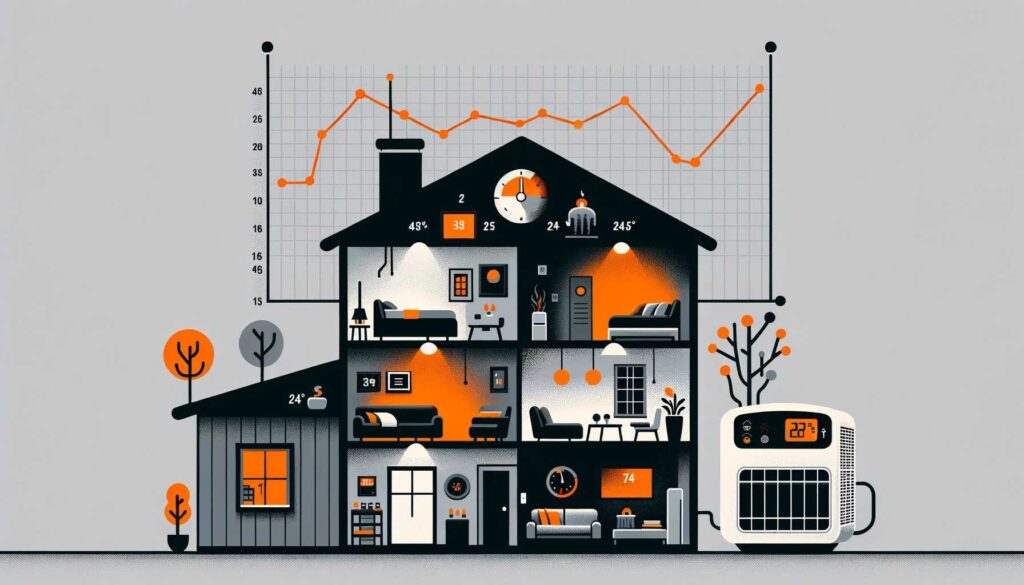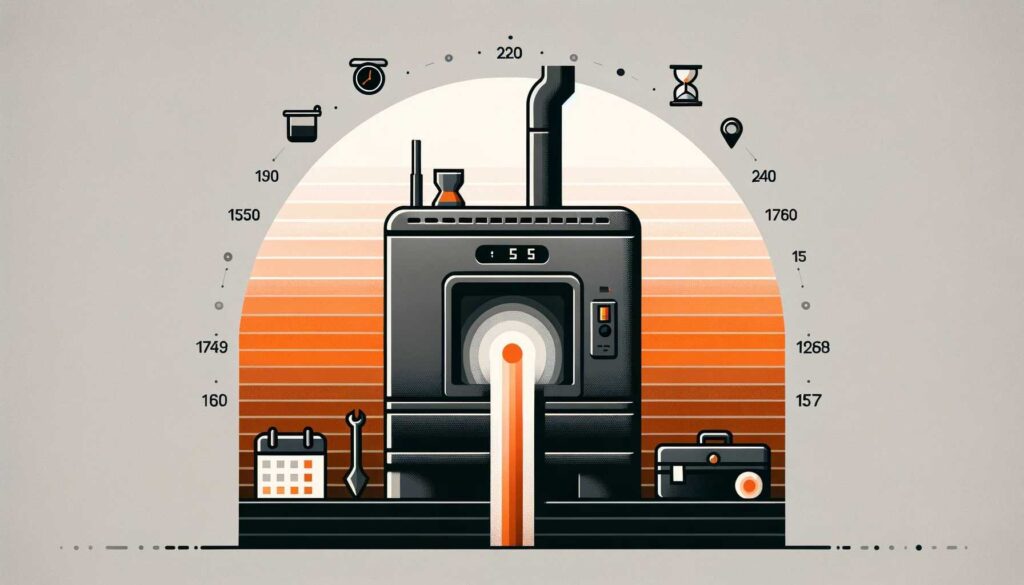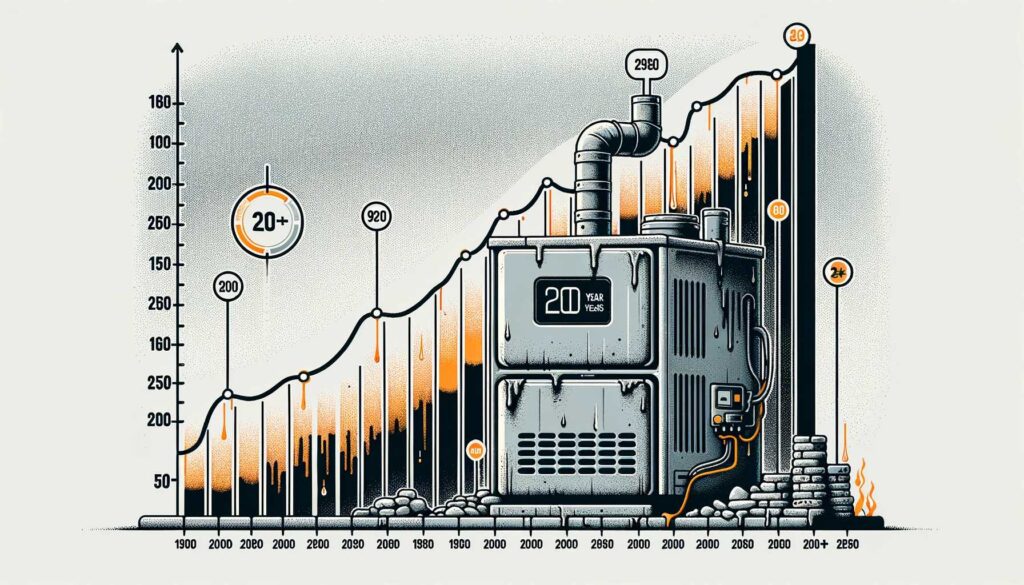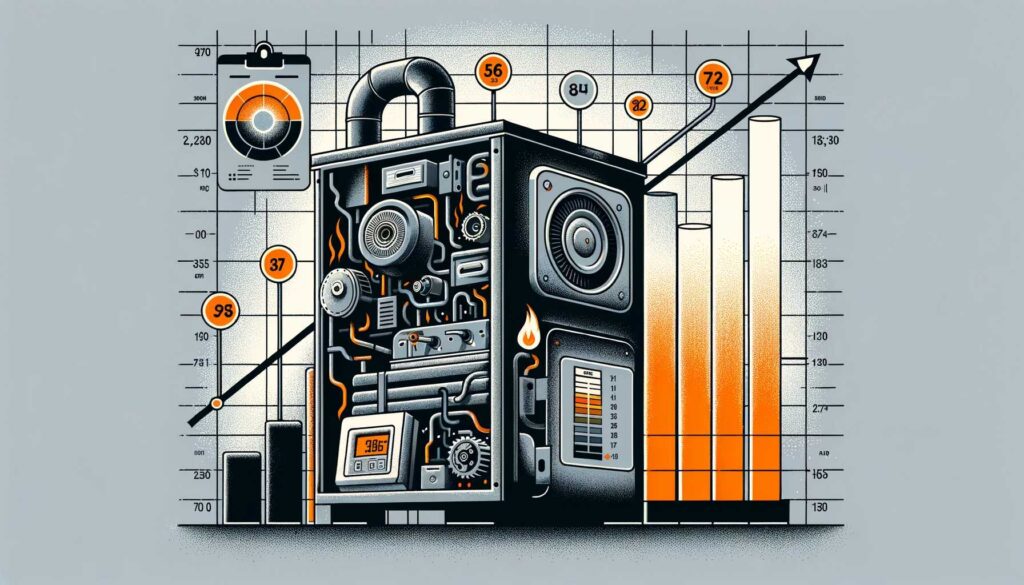Date: October 30, 2023
The furnace is an essential component of any home, providing warmth and comfort during the cold winter months. To ensure efficiency and safety, it is important to pay attention to the signs that indicate a need for repair or replacement of the furnace. This blog post will discuss 10 telltale signs that can help identify when a furnace needs to be replaced.
In this post, we will cover understanding the lifespan of a furnace, recognizing the signs of a failing furnace, evaluating your options, and taking the next step. By understanding these signs and taking action accordingly, homeowners will be able to keep their homes warm and cozy all winter long.
Brief mention of the importance of a furnace in maintaining a comfortable home environment.
A furnace is one of the most important components of any home. It provides warmth and comfort during cold winter months, ensuring that residents remain comfortable in their homes no matter how low temperatures drop outside. Without a functioning furnace, it would be difficult for anyone to stay warm indoors during colder times of year.
Explanation of the need for timely replacement or repair to ensure efficiency and safety.
It is important to pay attention to any signs that indicate a need for repair or replacement of the furnace in order to maintain efficiency and safety in the home. If left unchecked, an aging or malfunctioning furnace can lead to higher energy bills due to increased usage or inefficient operation, as well as potential health risks from poor air quality caused by dust buildup or other contaminants. Taking action promptly when signs of a failing furnace are observed can help ensure that your home remains warm and safe throughout the winter months.
Understanding the Lifespan of a Furnace
A furnace is an essential part of any home, providing warmth and comfort during cold winter months. It is important to understand the lifespan of a furnace and recognize when it needs to be replaced or repaired in order to ensure efficiency and safety.
Average Lifespan of a Furnace
The average lifespan of a furnace is around 15-20 years, depending on the type of system installed in the home. The age of the furnace can be determined by looking at its serial number and date code. The serial number will indicate the date that the unit was manufactured, while the date code will tell you when it was installed.
Factors That Impact Longevity
There are several factors that can impact the longevity of your furnace, such as proper maintenance, quality installation, and how often it is used. If your furnace has been well-maintained over its lifetime, then it may last longer than expected. On the other hand, if it has not been properly maintained or if it has been used heavily for long periods of time, then it may need to be replaced sooner than expected.
It is important to understand the life expectancy of your furnace in order to determine when it should be replaced or repaired. By recognizing signs that indicate a failing furnace and taking proactive action, you can ensure that your home remains warm and comfortable throughout the year.
| Factor | Impact on Longevity |
| Proper Maintenance | Longer |
| Quality Installation | Longer |
| Heavy Usage | Shorter |
#1 – Inconsistent Heating
When it comes to understanding the signs of a failing furnace, one of the most common indicators is inconsistent heating. This can manifest itself in a variety of ways, such as some rooms in the home heating unevenly or temperatures fluctuating throughout the day. Generally speaking, an aging furnace will struggle to keep up with demands for consistent temperature control and will have difficulty maintaining a comfortable environment in all areas of the house.

Rooms Heating Unevenly
The most obvious sign that something is wrong with your furnace is if you notice that some rooms are significantly hotter or colder than others. If you’ve set your thermostat to a certain temperature but find that some areas of your home are still too cold or too hot, there could be an issue with your furnace’s ability to evenly distribute heat throughout your home. Inefficient air distribution can be caused by a variety of issues, such as clogged filters or ductwork problems.
Fluctuating Temperatures
Another telltale sign of an inefficient furnace is when temperatures start to fluctuate throughout the day. If you find that temperatures suddenly spike during certain times and then fall again shortly afterwards, this could be indicative of a malfunctioning system. An aging furnace can become overwhelmed when asked to maintain consistent temperatures over long periods of time and may start to cycle on and off more frequently than normal. This can lead to sudden changes in temperature throughout the day and should be addressed as soon as possible.
Rising energy bills may indicate an aging furnace, which loses efficiency due to worn out parts, dust buildup and lack of maintenance. Compare current bills to previous seasons to determine if furnace needs replacing.
#2 – Rising Energy Bills
One of the telltale signs that your furnace may need to be replaced is an increase in energy bills. If you have noticed a significant difference in what you are paying for heating compared to previous seasons, it could be a sign that your furnace is no longer running as efficiently as it used to.

As a furnace ages and its components wear down, its efficiency decreases. This means that the same amount of energy is being used to heat your home, but less heat is actually being produced. As a result, you may find yourself having to run the furnace more often or at higher temperatures in order to maintain the desired temperature in your home. This can lead to an increase in energy costs over time.
Comparison of Current Bills to Previous Seasons
If you want to determine whether or not your rising energy bills are due to an aging furnace, compare them with the bills from previous years or other seasons when you were using the same furnace. If there has been a dramatic increase in what you are paying for heating, then it could be an indication that your furnace needs replacing.
Explanation of How an Aging Furnace Loses Efficiency
An aging furnace loses efficiency due to several factors including worn out parts, dust buildup, and lack of maintenance. Worn out parts like belts and bearings can cause friction which makes it harder for the motor and fan to work properly and lowers efficiency. Dust buildup can also restrict air flow and reduce efficiency while lack of maintenance can cause issues with thermostat settings and other components resulting in lower levels of performance.
Unusual noises from furnace can indicate a repair or replacement need, such as rattling, banging, popping, squealing, grinding, or hissing. Contact a professional HVAC technician quickly to prevent further damage.
| Action | Potential Outcome |
| Contact a professional HVAC technician | Quickly resolve issue without needing to replace entire furnace |
| Take action quickly when noticing potential problems | Home stays warm and cozy all winter long |
#3 – Unusual Noises
Unusual noises coming from your furnace can be a telltale sign that it is in need of repair or replacement. If you hear any strange sounds such as rattling, banging, or popping, this could indicate an issue with the blower motor or other components of the system. Additionally, if you hear a squealing noise when the furnace turns on, this may mean that the belt connecting the blower motor to the fan has become worn and needs to be replaced.
Description of Sounds
When trying to diagnose a problem based on sound alone, it is important to pay attention to what type of noise you are hearing. A metallic grinding sound could indicate a problem with the blower motor bearings, while a loud rumbling noise could be caused by an issue with the burners. If you hear a hissing sound coming from your furnace, this could mean that there is air leaking out of one of the ducts in your home.
When To Call A Professional
If you notice any unusual noises coming from your furnace, it is important to contact a professional HVAC technician as soon as possible. The technician will be able to inspect your system and determine what is causing the noise so they can make any necessary repairs or replacements. In some cases, these issues can be resolved quickly and easily without having to replace your entire furnace. However, if left unchecked for too long these problems can cause further damage and lead to more costly repairs down the line.
It is important to take action quickly when you notice any signs that your furnace may need repair or replacement. Paying attention to unusual noises can help alert you to potential problems before they become worse and ensure that your home stays warm and cozy all winter long.
Frequent repairs, costly repairs , and emergency services are signs that furnace replacement may be more economical than repair.
#4 – Frequent Repairs
frequent repairs are one of the most telling signs that your furnace needs to be replaced. If you’ve been paying for regular repair services, it may be time to invest in a new system. Not only is frequent repair expensive, but it’s also an indication that your furnace is nearing the end of its lifespan and can no longer meet your home’s heating needs.
Repair Frequency and Costs
If you’re calling for repairs more than once a year, it could be a sign that your furnace isn’t functioning properly. The cost of the repairs should also be taken into consideration. If the cost of multiple repairs begins to exceed the cost of replacing your furnace, then it might be time to invest in a new system.
Determining When Replacement is More Economical
It can be difficult to determine when replacement is more economical than repair, but there are some indicators you can look out for. If you’ve already had major components such as motors or heat exchangers replaced, this could signal that further repairs will not make financial sense in the long run. Additionally, if you find yourself calling for emergency services more often than not, this could mean that replacement would be a wiser investment than continuing with costly repair work.
No matter how well-maintained your furnace is, eventually it will need to be replaced due to age and wear and tear. Paying attention to signs such as frequent repairs can help you determine when it’s time to replace your system so you don’t have to worry about unexpected breakdowns or inefficient performance during cold weather months.
#5 – Age of the Furnace
The age of a furnace is one of the most telling signs that it may need to be replaced. On average, furnaces have a lifespan of 15-20 years. However, this is dependent on several factors such as how well it’s maintained, how often it’s used, and the climate in which it operates. It’s important to evaluate the performance of your furnace over time so you can determine when it’s time to replace it.

1. Reference to the Average Lifespan
When considering whether or not to replace your furnace, it’s important to keep in mind its average lifespan. most furnaces last between 15-20 years, but if yours has been around for longer than that, then you may want to start thinking about replacing it. Even if your furnace is still running properly after 20 years, chances are that its efficiency and effectiveness have decreased significantly over time and you might be better off making an upgrade.
2. Evaluating Performance Over Time
Another way to gauge whether or not your furnace needs to be replaced is by evaluating its performance over time. If you notice that your energy bills are rising despite no change in usage or temperature settings, then that could be a sign that your furnace isn’t operating as efficiently as it used to and may need to be replaced soon. Additionally, if you hear strange noises coming from your furnace or find yourself having to make frequent repairs, then these could also be indicators that replacement is necessary sooner rather than later.
#6 – Discolored Pilot Light
The pilot light is a small flame that ignites the gas burner when the furnace is turned on. It should typically be a blue or yellow color, indicating that it’s burning correctly and efficiently. If the pilot light is orange or red, this could signal an issue with the gas flow or air pressure in the furnace. In some cases, it might be caused by a dirty flame sensor or clogged air filter. It’s important to inspect the pilot light every few months to ensure it’s burning properly.
If you notice that your pilot light has changed color, you should call a professional for help right away. A technician will be able to identify what’s causing the discoloration and can provide advice on how best to proceed. Depending on what they find, you may need to have your furnace repaired or replaced entirely.
Safety Considerations
When inspecting your pilot light, always remember to exercise caution and safety. Make sure all power sources are shut off before beginning any work on your furnace, and never attempt to repair any of its components yourself without prior experience. If you’re unsure about anything, contact a professional for assistance instead of trying to troubleshoot yourself as this could put you at risk of injury or worse.
#7 – Increased Dust and Dry Air
Dust and dry air are two telltale signs of a failing furnace that should not be overlooked. As furnaces age, their efficiency can begin to decline, resulting in a decrease in air quality. This can lead to an increase in dust particles in the home, which can aggravate allergies and other respiratory conditions. In addition, the air may become drier than usual due to insufficient humidity levels.
1. Relationship between Furnace Efficiency and Air Quality
The efficiency of your furnace is directly related to the quality of air circulating throughout your home. As a furnace ages, its ability to filter out dust and other contaminants from the air is reduced. This can cause an accumulation of dust particles within your home, leading to an increase in sneezing and coughing for those with allergies or asthma. Additionally, an aging furnace may be unable to maintain proper humidity levels within the home, resulting in dry air that can cause skin irritation and nosebleeds.
2. Potential Health Implications
When dust particles accumulate in the home due to a failing furnace, it can create a number of health problems for those living there. Allergies and asthma can be exacerbated by the presence of dust particles in the air, leading to increased coughing and wheezing as well as difficulty breathing. Additionally, dry air caused by inadequate humidity levels can lead to skin irritation and discomfort as well as nosebleeds due to dehydration of nasal passages. Therefore, it is important to take action when signs of a failing furnace are present in order to protect your family’s health and wellbeing.
Evaluating Your Options
When it comes to deciding whether to repair or replace your furnace, it is important to consider both the short-term and long-term costs. Repairing a furnace can be an economical solution in the short term, but if you have an older model that requires frequent repairs, it may be more cost effective to invest in a new furnace. In addition to cost, you should consider how much longer your current system will last and what kind of energy efficiency you can expect from a new unit.
Repairing vs Replacing
When weighing the cost of repairing versus replacing your furnace, there are several factors to consider. The age and condition of your current system will play a large role in determining which option is more cost effective. If you have an older system that requires frequent repairs, then replacing it with a newer model may ultimately save you money in the long run. You should also take into account the energy efficiency of a new system compared to your existing one as this can help reduce energy bills over time.
Choosing a New Furnace
When selecting a new furnace for your home, there are several factors that should be taken into consideration. The size of the unit should be based on the square footage of your home and how many rooms need heating. Additionally, you should look at the fuel source options available such as gas, electric, oil or propane; each type has their own advantages and disadvantages so it is important to research which one would best suit your needs and budget. Finally, you should look at different types of furnaces such as single-stage, two-stage or modulating models; each offers varying levels of efficiency and comfort depending on your preferences and lifestyle.
Proactive action is essential to extend furnace life and maximize energy savings. Professional inspections can help determine best course of action and provide cost estimates. Selecting the right furnace size , efficiency and type of fuel is important for replacement.
Taking the Next Step
When signs of a failing furnace are observed, it is important to take proactive action and address the issue promptly. Scheduling a professional inspection is an important first step in determining whether repair or replacement is the best option. During the inspection, the technician will be able to assess any damage and provide an accurate cost estimate for repairs or replacement.

Scheduling a Professional Furnace Inspection
A certified technician can provide a comprehensive evaluation of your furnace, as well as offer advice on the most appropriate course of action. The technician should also be able to provide an estimate for any potential repairs or replacement costs.
Preparing for Furnace Replacement
If replacement is necessary, there are several factors that should be taken into account when selecting a new furnace. Size, efficiency rating and type of fuel are all important considerations when choosing the right unit for your home. Additionally, depending on your budget, you may want to opt for more advanced features such as zone control and smart thermostats that can help maximize energy savings over time.
Emphasizing the Benefits of Proactive Action
Taking proactive steps to ensure that your furnace is running efficiently and safely will help keep your home comfortable and cozy throughout the winter months while avoiding costly repairs down the line. Investing in regular maintenance and addressing signs of wear and tear quickly can help extend the life of your furnace and ensure you get maximum value from your investment in heating equipment.
At Champion Services, we understand the importance of a reliable furnace in maintaining a comfortable home environment. We hope this blog post has provided you with the knowledge to recognize the 10 telltale signs of a need for replacement. If you observe any of these signs, it’s best to act promptly and schedule an inspection with a professional HVAC technician. With timely action, you can ensure your family is safe and warm throughout the winter season. Contact us today to learn more about our services and how we can help you with all your heating needs!
Are you in need of plumbing, HVAC, or electrical services? Look no further than Champion Services! Our family-owned and operated business has been serving the Evanston, WY and Ogden, UT area since 1982. We provide top-notch services at a fair and reasonable price point. Our team is available day and night for repairs, maintenance, new installations, and replacements. Contact us today to experience fast and convenient service.

